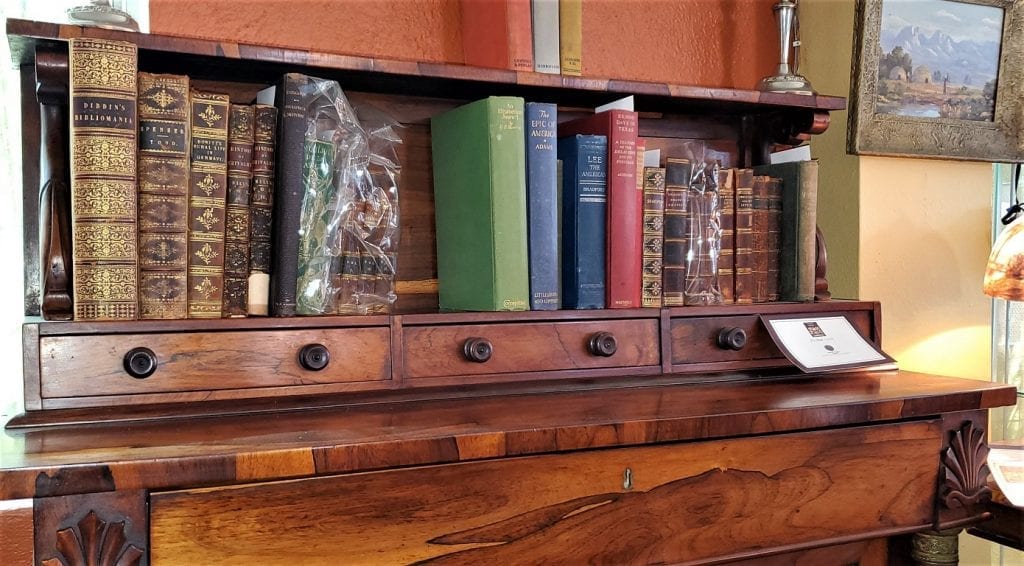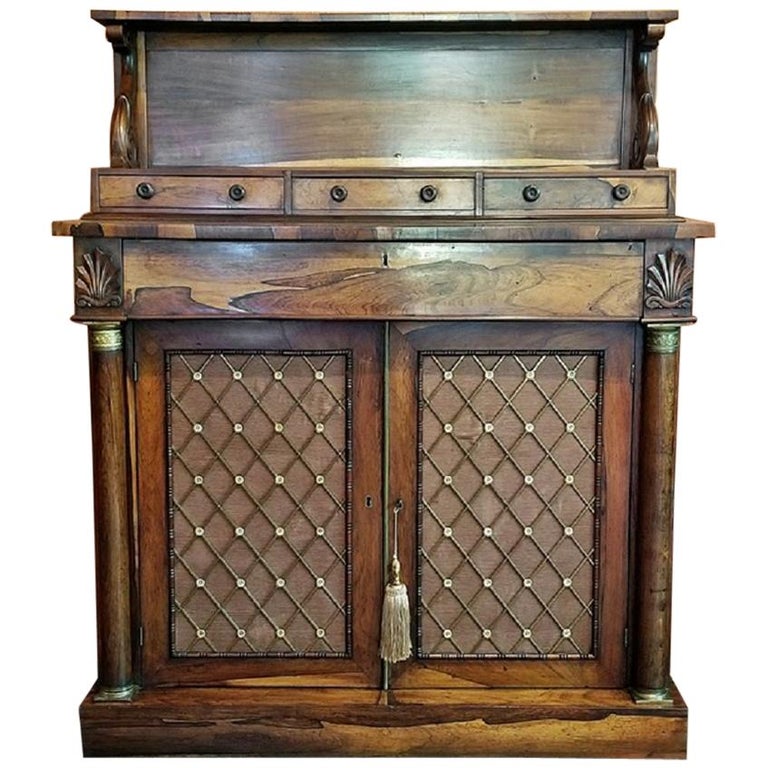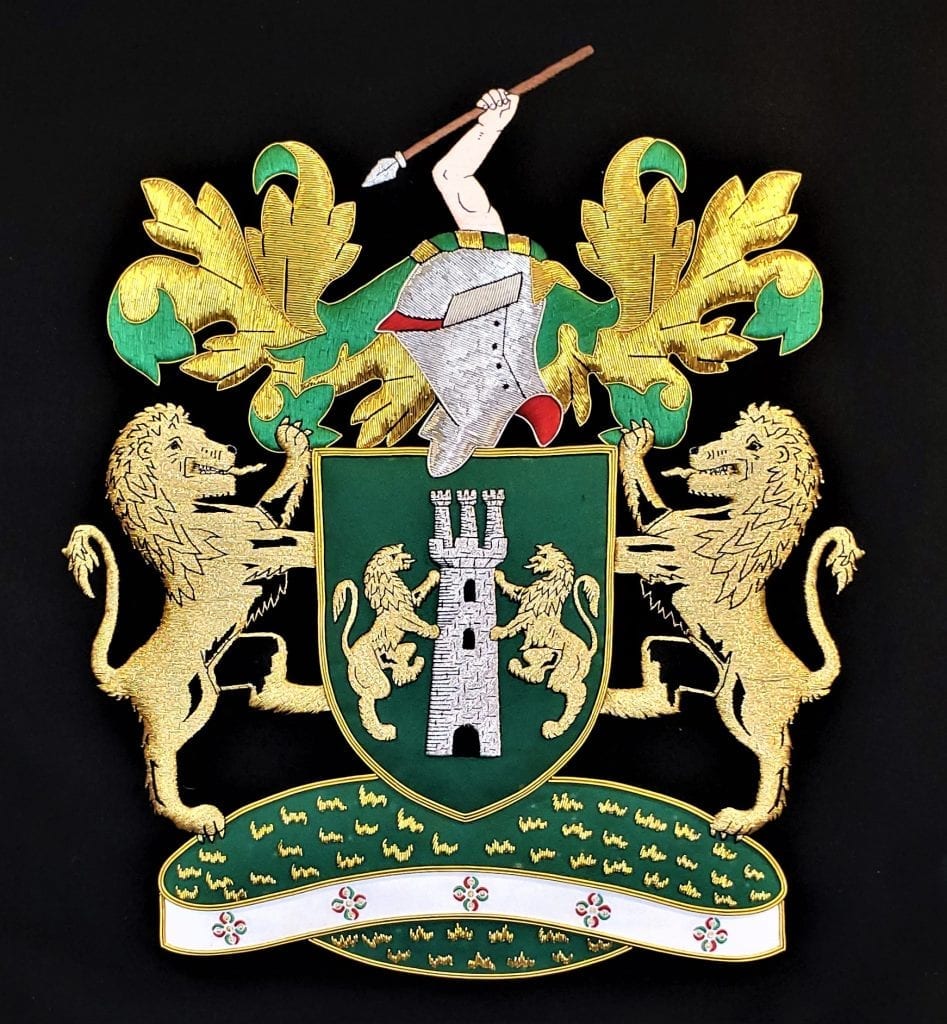18C British Regency Bureau and Chiffonier in the Manner of Gillows
PRESENTING A GLORIOUS 18C British Regency Bureau and Chiffonier in the Manner of Gillows.
HIGHLY DESIRABLE AND IMPORTANT ITEM FROM AN EXCEPTIONAL MAKER!
EXCEPTIONAL QUALITY!
Fantastic piece, in super original condition.
A ‘Period’ Regency, rosewood Bureau/Secretary Desk and Chiffonier Cabinet of lovely proportions.
London made piece, from circa 1790-1800.
Entirely made of the ‘highest quality’, beautifully grained and patinated rosewood veneer(s). Typical of the type and style used by ‘Gillows’ at that time.
The top portion consists of an open open bookshelf with curved pelmet and side scrolling pillars.
It has a series of 3 drawers underneath.
The bottom ‘chiffonier/cabinet’ section is a double door cabinet with double shelving inside. Original lock and working key. The door on the right, has a brass molding on the closing side to neatly cover the area between the doors.
The façade of the doors, consist of a large panel on each, in rectangular shape and edged with decorative wooden trim/molding and inside the panel are glorious gilded brass latticework frames, with rose shaped connectors/medallions and with brown silk blinds to the rear of the latticework.
The Bureau/Desk Section above these doors, closes to look like a flat drawer, but when pulled out a few inches, reveals concealed buttons on either side that when pressed, drop-down the drawer front to reveal the writing slope with inset red velvet (a replacement) and with gallery to the rear with 2 satinwood drawers with their original ivorine pulls/knobs and a central open space for storage.
Beautiful cylindrical support columns/pillars on both sides of the chiffonier base, with HIGH QUALITY brass mounts on the top of each, highly embossed with floral designs and square brass mounts on the base of each pillar.
Very typical of the Regency period!
Large molded acanthus leaf medallion motifs, on either side of secretary drawer.
This is a English (London) piece and most definitely in the Manner of Gillows of Lancaster & London!
Like most ‘Gillows’ pieces there is no mark or label, but we have dealt in many ‘Gillows’ pieces over the years and have ‘no hesitation’ in attributing this to ‘Gillows’.
When we bought this from a reputable high-end antique dealer friend in Ireland, he had been approached by 3 different London dealers looking to buy it, but kept if for us, that’s what friends are for! LOL
We paid a considerable sum for it 20 years ago and will not break even with the ‘sale price’, it is now listed at (especially when you factor in the shipping to the US) …. so whomever ‘snaps this up’ is really getting a bargain!
We have ‘loved’ it, as part of our own private collection, but it is time for it to find a new home!
Nicest one of its kind we have ever seen!
Gillows of Lancaster and London, also known as Gillow & Co., was an English furniture making firm based in Lancaster, Lancashire, and in London. It was founded around in Lancaster in about 1730 by Robert Gillow (1704–1772).
Gillows was owned by the family until 1814 when it was taken over by Redmayne, Whiteside, and Ferguson; they continued to use the Gillow name. Gillows furniture was a byword for quality, and other designers used Gillows to manufacture their furniture. Gillows furniture is referred to by Jane Austen, Thackeray and the first Lord Lytton, and in one of Gilbert and Sullivan’s comic operas. In 1903 Gillows merged with Warings of Liverpool to become Waring and Gillow and although the furniture remained of a high quality it was not as prestigious.
By the mid-18th century the firm was one of the leading cabinet-makers in Lancaster. They had a reputation for manufacturing very high quality furniture. By the end of the 1700s most of the firm’s partners were based in London. The firm merged with a Liverpool firm in 1897 to form Waring & Gillow.
Gillow family (1728–1814)
In 1728 Robert Gillow began trading in Lancaster as a joiner, builder, house carpenter, furniture maker and overseas merchant. By the summer of 1731 he had entered into a partnership with a fellow catholic, George Haresnape, which had ended by 1735. By 1734 six other names appeared on their staff list.[8] Gillows notably made heavy use of mahogany wood, which is indigenous to the Americas, from the early 1730s. In the early 1740s, Gillow owned a twelfth share of the ship Briget, which he partially used to import mahogany from the West Indies. The success of the firm was partly due to his ability to directly import mahogany; by 1742 Gillow was exporting finished mahogany furniture back to the West Indies.
On 1 January 1757 Robert entered into an equal partnership with his son Richard Gillow (1733–1811), and the firm was known as Robert Gillow & Son. Richard was also the architect for several buildings in Lancaster. He financed the building of the catholic church in Dalton Square, Lancaster in 1798. The family’s Catholic history [b] was important in building up a customer base within Lancashire’s gentry, and their subsequent purchase of Leighton Hall, Lancashire from a cousin in 1822. On 31 December 1768 Robert Gillow I retired and left his share of the firm to his other son, Robert Gillow II (1747–1795). In 1769 and 1770, a shop at 176 Oxford Street, London, was sent up by the brothers’ cousin, Thomas Gillow (1736–1779), to sell their furniture. Goodison and Hardy state that the firm opened a London branch in 1760 at 176 Oxford Road. By 1775 the Lancaster branch had 42 employees, and by 1789 there were about 50 employees.
Pieces of Gillow furniture can now be seen in museums in London, Leeds, Adelaide, Melbourne, and Auckland, as well as a collection in the Gillow Museum in the Judges’ Lodgings, Lancaster. The furniture can also be seen in houses open to the public such as Tatton Park.
Link: https://en.wikipedia.org/wiki/Gillows_of_Lancaster_and_London
18C British Regency Bureau and Chiffonier in the Manner of Gillows
Dimensions: 51 inches Tall, 42.5 inches wide and 16 inches deep (23 inches deep with secretaire desk open)
Provenance: Bought privately from a reputable dealer in Ireland.
Condition: Very good original condition. Some very minor blemishes through age, but nothing that would devalue the piece.
PRICE: $17,500 – SALE PRICE NOW: $7,875




























